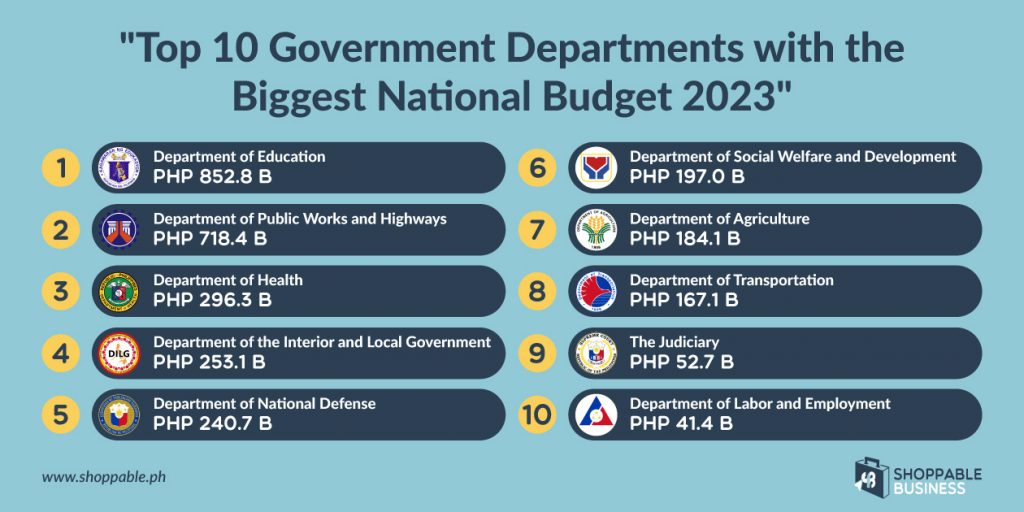
For every fiscal year, the Philippines proposes and approves a national budget for the prosperity of economic development and sustainability of the country. For the fiscal year of 2023, the national budget is P5.268 trillion, an increase of 4% or P244B, compared to 2022’s national budget of P5.0.24 trillion. Are you curious which government departments have the most budget this 2023? Then, you’re in the right place. In this article, we will discuss the Top 10 Philippine government departments with the biggest national budget this 2023 and how the national budget is prepared for every fiscal year.
What is Government Budgeting
Government budgeting in the Philippines is an utmost vital process where money earned and borrowed is allocated to the country’s economic and social objectives. This involves wisely spending the national budget to get the most economic benefits from producing and delivering goods and services while maintaining a stable budget throughout the fiscal year.
Through the careful budgeting and allocation of the government funds, the national budget in the Philippines is allocated to all government departments to implement, spearhead government programs and projects that would help aid the livelihood of the masses.
Key Priorities of the National Budget this 2023
The key priorities of the national budget this 2023 is to address key and immediate issues confronting the Filipino people such as low income, rising inflation, and socioeconomic implications during the pandemic.
- Strengthen the purchasing power of Filipinos – this includes: food security, improved transportation, affordable and clean energy
- Reduce vulnerability and mitigate scarring from the COVID-19 pandemic – this includes: social services, healthcare, education
- Ensure sound macroeconomic fundamentals – this includes: Bureaucratic efficiency, sound fiscal management.
- Support Local Governments – empower local government units (LGUs) in delivering the services that have been delegated to them.
The Top 10 Philippine Government Departments with the Biggest National Budget 2023

The P 5.268T national budget of the Philippines this 2023 is divided into the following:
- 39.2%, on social services;
- 29.2%, on economic services;
- 15.3%, on general public services
- 11.6% on debt burden; and
- 4.7% on defense.
- Department of Education – Php 852.8 B
The highest priority in the national budget this 2023 is the Department of Education (DepEd).
in the Philippines is the government agency responsible for overseeing and managing the country’s basic education system. It is the main agency tasked with formulating and implementing policies, plans, and programs related to primary, secondary, and alternative learning systems in both public and private schools.
- Department of Public Works and HIghways – Php 718.4 B
With an allocation of Php 718.4 billion, the Department of Public Works and Highways comes at second priority to continue the Build, Build, Build or to fuel the Build, Better, More program. essential for the economic transformation and to generate more jobs in the Philippines.
- Department of Health – Php 296.3 B
Third on the list is the Department of Health, with an allocation of Php 296.3 billion, as the Philippines continue to address the pandemic and expand health care systems to the regions all over the country.
- Department of the Interior and Local Government – Php 253.1 B
The Department of the Interior and Local Government (DILG) is a government agency in the Philippines responsible for promoting peace, public safety, and local governance in the country. A total of Php 253.1 B will go to LGUs in provinces, cities, municipalities, and barangays.
- Department of National Defense – Php 240.7 B
The Department of National Defense (DND) is a government agency in the Philippines responsible for the defense and security of the country. About Php 240.7 B of the national budget will be allocated to the service of the military or the Armed Forces of the Philippines (AFP).
- Department of Social Welfare and Development – Php 197.0 B
The Department of Social Welfare and Development (DSWD) in the Philippines is a government agency responsible for promoting social welfare and providing support to vulnerable and disadvantaged individuals and families. The DSWD has an allocation of Php 197.0 billion to address the needs of the poor and marginalized, among other targeted sectors of the economy.
- Department of Agriculture
The Department of Agriculture (DA) in the Philippines is a government agency responsible for promoting and supporting the development of the agriculture sector in the country – such as farming, cultivation of crops, animals, and poultry. The Department of Agriculture has an allocation of Php 184.1 billion and a much-needed 39.2% increase from its 2022 allocation, to focus on growing and promoting agriculture in the country.
- Department of Transportation – 2023: Php 167.1 B
The Department of Transportation (DOTr) in the Philippines is a government agency responsible for the planning, implementation, and regulation of transportation systems and infrastructure in the country – which includes, air, land, sea, and rail transportation systems. The DOTr has an allocation of Php 167.1 billion or a 120.4% increase, hoping to better the commuting experience of Filipinos.
- The Judiciary – Php 52.7 B
The Judiciary in the Philippines is one of the three branches of government, alongside the Executive and Legislative branches. It is responsible for interpreting and applying the laws of the land, ensuring that justice is served, and resolving disputes in a fair and impartial manner. The Judiciary is composed of the Supreme Court, Court of Appeals, and other courts under the department, with an allocation of Php 52.7 B.
- Department of Labor and Employment – Php 41.4 B
The Department of Labor and Employment (DOLE) in the Philippines is a government agency responsible for formulating policies, programs, and regulations related to labor and employment. The Filipinos hope the government addresses the rising unemployment rate of 4.8% last January 2023 with the Php 41.4 B budget.
How is the National Budget Prepared for every fiscal year?
Preparing the national budget involves a meticulous, series of steps that starts with the Development Budget Coordinating Committee (DBCC) setting the country’s economic target, deciding on spending amounts, estimating revenue, and planning how to maintain and sustain the fiscal budget.
The DBCC is a group of government officials that collaborate and work together as an inter-agency body, including the DBM Secretary as Chairman, the Bangko Sentral Governor, the Secretary of the Department of Finance, the Director General of the National Economic and Development Authority, and a representative from the Office of the President.
The preparation of the national budget is as follow, according to the Department of Budget and Management (DBM):
- Determination of overall economic targets, expenditure levels and budget framework by the DBCC;
- Issuance by the DBM of the Budget Call which defines the budget
framework; sets economic and fiscal targets; prescribe the priority thrusts
and budget levels; and spells out the guidelines and procedures, technical
instructions and the timetable for budget preparation;
- Preparation by various government agencies of their detailed budget estimates ranking programs, projects and activities using the capital budgeting approach and submission of the same to DBM;
- Conduct a budget hearings were agencies are called to justify their proposed budgets before DBM technical panels;
- Submission of the proposed expenditure program of department/agencies/special for confirmation by department/agency heads.
- Presentation of the proposed budget levels of department/agencies/special purpose funds to the DBCC for approval.
- Review and approval of the proposed budget by the President and the Cabinet;
- Submission by the President of proposed budget to Congress. To meet the Constitutional requirement for the submission of the President’s budget with 30 days from the opening of each regular session
How is the National Budget Implemented

According to the Department of Budget Management, the budget implementation begins with releasing funds to government agencies. To streamline this process and ensure efficient use of funds, the government introduced the Simplified Fund Release System (SFRS) in 1995. Unlike the previous system, the SFRS standardizes fund releases based on policy initiatives.
The agency budget matrix (ABM) is prepared by the DBM in collaboration with agencies at the start of each budget year. It breaks down the budget for each agency into different expenditure categories, serving as a blueprint for fund release timing and amounts.
The Allotment Release Program (ARP) prioritizes fund releases based on available resources and economic goals. This leads to issuing General Allotment Release Orders (GAROs) or Special Allotment Release Orders (SAROs) to authorize agencies for spending.
The Notice of Cash Allocation (NCA) is then released by the DBM monthly or quarterly, specifying the maximum withdrawal amount from government banks. The Bureau of the Treasury replenishes these banks daily with funds to cover authorized checks presented by agencies.
Agencies have flexibility in using NCAs under the “Common Fund” concept, as long as the allotted amounts for specific purposes are not exceeded. This speeds up project implementation.
How about the Confidential, Intelligence Funds?
The office of the President is asking for P9.2 Billion for confidential and intelligence funds, which is said to be allocated to support surveillance activities of civilian government agencies. The use of such funds has faced significant backlash, criticism, and suspicion concerns of the Filipino people, possibly aimed at corruption. These appropriations are not subject to the standard audit procedures by the Commission on Audit, which raises transparency and accountability issues.









